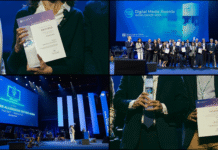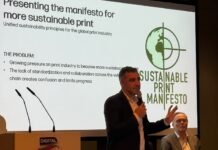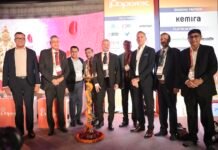Kyocera has announced a new inkjet textile printer, the Forearth, which marks its first entry into the textile printer market.
Sho Taniguchi, general manager from the industrial printing business development office for Kyocera Document Solutions, told me at last year’s IGAS show that Kyocera wants to play a part in helping the textile industry transform itself into a more sustainable future based on digital print technology. To this end, Kyocera set out to develop one of the most sustainable textile printers.
Kyocera has developed a proprietary pigment ink, called Kyocera Precision Ink or KPI, that allows it to reduce the amount of water used in production by eliminating the need for pre- and post-treatment processes. As well as the ink, Kyocera has also developed a pre-treatment liquid and finishing agent that will allow this printer to work with a wide range of fabrics, including cotton, silk, and polyester to nylon and blended fabrics.
The printer itself uses just 0.02 litres of water, and that just to wash the transfer belt. The reduction in water consumption is a key part of the value proposition here for Kyocera, and for most other digital textile printer vendors, since most textile production uses a conventional dying approach that has made it one of the most polluting industries on the planet.
Naturally the Forearth printer uses Kyocera printheads, complete with full recirculation, with 600 x 600 dpi resolution. The printer uses a multi pass scanning approach with a linear motor to drive the carriage with a high degree of accuracy. The printheads for the pretreatment, print and finishing agent are all stacked together on the print carriage, which can take up to 18 heads in total. The Forearth will take substrates up to 1.85 meters and print up to 1.8 meter wide. It can produce up to 250 square meters an hour.
It can be configured with up to eight colors – CMYK plus orange, red, green and blue. I believe that Kyocera is also working on a white ink that should be available with the next iteration.
Kyocera’s decision to build its own textile printer is an interesting development given that Taniguchi says that Kyocera supplies around 50 percent of the inkjet printheads used in the textile market. He adds, “We don’t want to fight with our head customers. But analog printing is still only 90% so it’s not necessary to cannibalize the digital market. And the population is still increasing so the ratio will change.”
But I think the bigger picture here is that Kyocera, through its Document Solutions business, is expanding from its existing office printing business into the commercial print market, just as other Japanese companies such as Konica Minolta, Epson and Ricoh have done in the past. The company has had considerable success with its entry level color inkjet production printer, the TaskAlfa 15000c, and introduced a mono version at the end of last year. Kyocera has also announced plans for a more upmarket model that will take coated papers. And earlier this year Kyocera acquired the French inkjet specialist, Nixka, a clear statement of its intent to expand its own inkjet printers.
ITMA in Milan in June
The Forearth will be shown for the first time in Europe at the ITMA show in Milan in June. It should be pointed out that several other vendors have also been working on developing pigment inks for multi-pass textile printers, for all the reasons that Kyocera has, and which will also be on show at ITMA.
There are three principal advantages to using pigment inks. Firstly, these inks will cut down on the pre- and post-processing stages, which will in turn also reduce the amount of water used, making for a much more sustainable solution. Simplifying the various processes is also a first step in automating the production line, from printing to finished item, which is essential in setting up any kind of online ordering system. The third advantage is that pigment inks allow one printer to work with a wide range of materials, which makes for a much more flexible approach to textile production.
In general, digital textile printing is more environmentally-friendly than conventional textile production but also more expensive. The textile users – such as the bigger brands in the fashion industry – have not yet mastered the inventory management or print on-demand concept that would allow them to really take advantage of digital printing. So automating the production and standardising on a single ink type will play a big part in that. So, if this year’s ITMA, as expected, does showcase a number of pigment ink printers then it will mark a major milestone for textile printing.
The Forearth printer should be available by the autumn of this year. You can find further details from kyocera.com.
NB: Nessan Cleary will also be at ITMA so if anyone wants to meet with him, then do drop him a line.
Reprinted with permission from www.nessancleary.co.uk


















